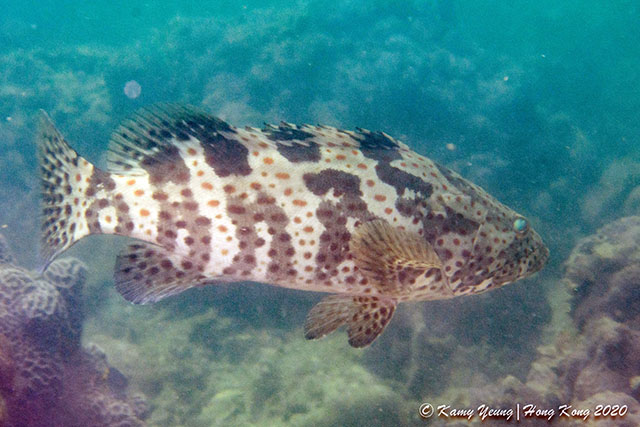| Epinephelidae (Groupers) |
| 120 cm TL (male/unsexed); max.weight: 15 kg; max. reported age: 22 years |
|
reef-associated; brackish; marine; depth range 1 - 100 m |
| Indo-West Pacific: Red Sea south to at least Durban, South Africa and eastward to Palau and Fiji, north to the Ryukyu Islands, south to the Arafura Sea (Ref. 9819) and Australia. Recently reported from the Mediterranean coast of Israel (Ref. 5222). Frequently misidentified as Epinephelus tauvina or Epinephelus malabaricus (Ref. 27362). |
|
Dorsal spines (total): 11-11; Dorsal soft rays (total): 13-16; Anal spines: 3-3; Anal soft rays: 8-8. This species is distinguished by the following characters: elongated body with greatest body depth at 2.9-3.7 in SL (for specimens 10-78 cm SL); head length 2.3-2.6 in SL. interorbital width 5.0-6.2 in HL; preopercle with enlarged serrae at angle and a broad shallow notch just above angle; upper edge of operculum straight or somewhat convex; maxilla reaches to or slightly past a vertical at rear edge of eye; upper jaw length 17-20% of SL; midlateral part of lower jaw with 2-3 rows of subequal teeth; gill rakers of first gill arch 8-10 + 14-17; pyloric caeca 50-60; lateral body scales rough, with minute auxiliary scales (body scales ctenoid except for nape, back, thorax, abdomen and above anal-fin base with cycloid scales); lateral-line scales 58-65; lateral-line tubes of anterior scales branched in adults. Colour: head and body tan dorsally, shading to whitish ventrally; numerous small brownish orange or reddish brown spots on head, body, and median fins; body with 5 faint, irregular, oblique, dark bars which bifurcate ventrally (irregular H-shaped bars); back with 3-4 blackish saddles; orange spots become poorly defined and darker with growth (Ref. 39231, 90102). |
| Inhabit turbid coastal reefs (Ref. 9710) and are often found in brackish water (Ref. 27362) over mud and rubble (Ref. 6390). Solitary (Ref 90102). Juveniles are common in shallow waters of estuaries over sand, mud and gravel and among mangroves (Ref. 6390). Feed on small fishes, shrimps, and crabs. Probably spawn during restricted periods and form aggregations when doing so (Ref. 27352). Females mature at 25 to 30 cm (2 to 3 years old), and sexual transition occurs at 55 to 75 cm (Ref. 39231). Eggs and early larvae are probably pelagic (Ref. 6390). Has been tested in several countries as a potential species for mariculture (Ref. 43448). Caught with hook-and-line, traps, trawls, and lift nets. Common and expensive in markets of the region; sold fresh and kept alive at restaurants in Asian countries (e.g. Hong Kong and Taiwan Province of China) (Ref. 39231). |
|
Least Concern (LC); Date assessed: 21 November 2016 Ref. (130435)
|
| harmless |
|
Distributed from the Houtman Abrolhos to Newcastle.
Commercial fishery: In Australian waters, rock cod are caught by demersal otter trawling, traps, droplines and handlines. In general however, they are not targeted in these fisheries, instead forming a major bycatch of emperor (Lethrinidae) and sea perch (Lutjanidae) fisheries. The highest recorded catches of rock cod in domestic fisheries up to 1989-90, were 39 t (Queensland, 1975-76), 14 t (Northern Territory, 1986-87) and 287 t (Western Australia, 1989-90). Also from Northern Australia (Ref. 89707).
Estuary rock cod is one of the major serranid species in the Northern Fish Trawl Fishery (Ref. 27275), which includes the North West Shelf, Timor Sea and Arafura Sea. This fishery was mainly worked by Taiwanese pair trawlers and some Thai stern trawlers and Chinese pair trawlers from about 1971 to 1991. Up until 1990, yellow-spotted rock cod, E. areolatus and estuary rock cod comprised 62% of the reported 'cod' catches by foreign vessels in northern Australia (bar-cheeked trout Plectropomus maculatus, was the other main species) (Ref. 27275).
In 1993, the highest catches of rock cod were made by Australian stern trawlers on the North West Shelf. Larger rock cod were less abundant in the Gulf of Carpentaria and the Arafura Sea.
On the North West Shelf, demersal trap and line fishing occurs mainly in the Exmouth to Point Samson (114°-117° E) and Broome areas. Estuary rock cod is one of the larger species harvested in this fishery.
In the Northern Territory, demersal trap, handline and dropline fishing is carried out mainly in the 'Timor Box' (a region between 127.5°E and 131°E). In 1991, serranids comprised 22% of the total catch from the Timor Box. Fish trapping is confined to areas with hard sea floor which are not worked by demersal trawlers.
In Queensland, rock cod are a component of the East Coast Reef Line Fishery. They are caught usually with handlines in shallower water and with droplines in deeper water. The main species caught are estuary rock cod, wire-netting cod (E. merra) and Maori cod (E. undulatostriatus). There is no information on the quantity of each species caught in Queensland.
Rock cod also form a small part of the bycatch from demersal otter trawling in Queensland. Throughout northern Australia they are an incidental catch in bottom set longlines and gillnets.
Smaller rock cod are marketed whole or gilled and gutted, either frozen or fresh chilled. Larger rock cod are sold whole but more often as fillets or cutlets.
Museum: USNM 174317, 174265; BMNH 1927.10.28.9; BPBM 31290; AMNH 57064, 37875; AMS IA.4125, IA.6737-008, I.16853-001; NTM S.11506-001, S.10773-004, S.10415-004, S.10013-002; S.11365-021. Also Ref. 4787, 3131, 3132, 6492, 33390, 37816. |
Source and more info: www.fishbase.org. For personal, classroom, and other internal use only. Not for publication.

